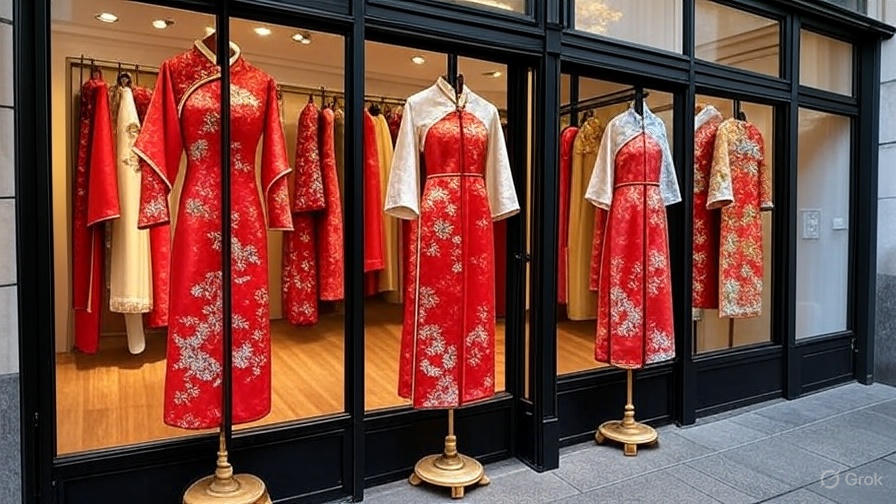
French fashion magazines once focused solely on Parisian runways. Now, they’re turning their gaze eastward. Chinese fashion, with its bold designs and rich cultural roots, is making waves in France’s media landscape. Platforms like RobesChinoises.fr showcase this shift, highlighting how Chinese aesthetics are reshaping European style narratives. This growing coverage reflects deeper trends—multiculturalism, evolving consumer tastes, and a media eager to embrace global influences. But what’s driving this fascination, and what does it reveal about France today?
Chinese fashion’s rise in French media began subtly but gained momentum fast. Designers drawing from traditionnelle elements—like qipao silhouettes or intricate embroidery—are catching the eye of French journalists. Vogue France and Elle have featured Chinese designers like Huishan Zhang and Uma Wang, praising their ability to blend heritage with modern flair. This isn’t just about aesthetics. It’s about storytelling. French media, known for its love of narrative, finds a fresh angle in Chinese designs that carry centuries of history. Consequently, these stories resonate with readers seeking authenticity in a globalized world.
Why the sudden interest? For one, multiculturalism is reshaping France. The country’s diverse population demands representation in fashion, and Chinese aesthetics offer a vibrant palette. Moreover, consumer trends are shifting. French shoppers, especially younger ones, crave unique pieces that stand out in a sea of fast fashion. Platforms like RobesChinoises.fr cater to this demand, offering curated collections that blend Eastern elegance with Western accessibility. As a result, French influencers are spotlighting these designs on social media, amplifying their reach. Instagram posts featuring silk cheongsams or hanfu-inspired dresses rack up thousands of likes, signaling a cultural crossover that’s hard to ignore.
A Shift in Media Narratives
French fashion journalism has long been a gatekeeper of style. Yet, its coverage of Chinese fashion marks a departure from tradition. Previously, Paris-centric narratives dominated, with little room for non-Western influences. Now, outlets like Le Monde and Marie Claire are dedicating spreads to Chinese designers. They’re not just showcasing clothes but exploring the cultural significance behind them. For instance, articles often delve into the symbolism of colors like red for luck or the craftsmanship of Suzhou embroidery. This shift reflects a broader openness in French media to global stories, driven by a desire to stay relevant in a connected world.
However, this coverage isn’t without challenges. Some critics argue that French media risks exoticizing Chinese fashion, framing it as “other” rather than universal. Others see it as progress, a step toward inclusivity. The truth likely lies in between. By highlighting Chinese designers, French media is broadening its lens, but it must tread carefully to avoid stereotypes. Platforms like RobesChinoises.fr play a key role here, presenting Chinese fashion as accessible and modern, not just a cultural artifact. This balance helps normalize the trend while respecting its roots.
READ ALSO: Are there Rules or Standards for Boutique Hotels?
Consumer Trends and Global Influence
Beyond media, consumer behavior is fueling this trend. French shoppers are increasingly eco-conscious and value-driven, seeking brands with cultural depth. Chinese fashion, with its emphasis on craftsmanship, aligns perfectly. Small boutiques in Paris now stock Chinese-inspired designs, and online searches for terms like “qipao dress” have spiked. Meanwhile, French influencers are collaborating with Chinese brands, creating a feedback loop that keeps the trend alive. This consumer-driven demand pushes media to cover Chinese fashion more prominently, creating a cycle of visibility and influence.
What’s next for this cross-cultural exchange? Chinese fashion’s foothold in France is likely to grow. As trade ties between China and France strengthen, so does cultural exchange. Fashion weeks in Shanghai and Beijing are gaining attention from French journalists, who see them as rivals to Paris’s dominance. Yet, this isn’t a competition—it’s a conversation. French media’s embrace of Chinese aesthetics shows how fashion can bridge cultures, telling stories that resonate across borders. Platforms like RobesChinoises.fr are at the heart of this dialogue, proving that style knows no boundaries.
In short, Chinese fashion’s rise in French media reflects a world in flux. It’s about more than clothes—it’s about identity, connection, and the power of storytelling. As France continues to embrace global influences, Chinese designs will likely shape its fashion narrative for years to come. Isn’t that a beautiful thing?

